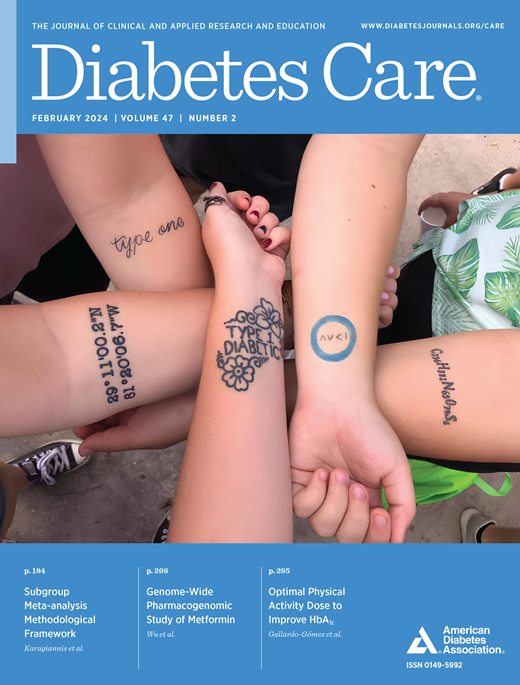Early Continuous Glucose Monitor Use in Children and Adolescents With Type 1 Diabetes: Rates of Initiation and Impact on Glycemic Outcomes
IF 16.6
1区 医学
Q1 ENDOCRINOLOGY & METABOLISM
引用次数: 0
Abstract
OBJECTIVE Early initiation of continuous glucose monitor (CGM) after type 1 diabetes (T1D) diagnosis has been associated with lower hemoglobin A1C (HbA1c) in single-institution studies. This multicenter study evaluated the association between the timing of CGM initiation and HbA1c at 3 years postdiagnosis. RESEARCH DESIGN AND METHODS Data were obtained from the T1D Exchange Quality Improvement Collaborative (T1DX-QI) electronic health record database from 25 pediatric centers and included children and adolescents ≤18 years old diagnosed with T1D in 2019 and 2020. CGM initiation and glycemic outcomes were followed for 3 years after diagnosis. Locally estimated scatterplot smoothing plots evaluated the relationship between timing of CGM initiation and HbA1c over time, and logistic regression models were used to adjust for potential confounders. RESULTS There were 4,164 people included in this analysis, mean age was 12.6 (SD 3.5) years, and 37% had public health insurance. Of the 93% (n = 3,877) who initiated CGM within 3 years of T1D diagnosis, 21% did so at 0–3 months, 14% at 3–6 months, 14% at 6–12 months, and 51% after 12 months. Median HbA1c at 3 years postdiagnosis was lower for the 0–3 and 3–6 months groups compared with the 6–12 months and non-CGM user groups (7.9%, 7.9%, 8.4%, and 9.5%, respectively). Adjusted odds of HbA1c >9% were lowest for the 0–3 months group followed by the 3–6 months group. CONCLUSIONS In summary, early initiation of CGM within the first 6 months of diagnosis is associated with improved HbA1c outcomes at 3 years postdiagnosis.儿童和青少年1型糖尿病患者早期连续血糖监测仪的使用:启动率和对血糖结局的影响
目的:在单机构研究中,1型糖尿病(T1D)诊断后早期开始连续血糖监测(CGM)与较低的血红蛋白A1C (HbA1c)相关。这项多中心研究评估了CGM开始时间与诊断后3年HbA1c之间的关系。研究设计和方法数据来自25个儿科中心的T1D交流质量改进协作(T1DX-QI)电子健康记录数据库,包括2019年和2020年诊断为T1D的≤18岁的儿童和青少年。诊断后随访CGM起始和血糖结局3年。局部估计的散点图平滑图评估了CGM开始时间与HbA1c随时间的关系,并使用逻辑回归模型来调整潜在的混杂因素。结果共纳入4164人,平均年龄为12.6 (SD 3.5)岁,37%的人有公共健康保险。在确诊为T1D的3年内开始CGM的93% (n = 3877)中,21%在0-3个月时开始,14%在3 - 6个月,14%在6-12个月,51%在12个月后开始。诊断后3年,0-3个月和3 - 6个月组的中位HbA1c低于6-12个月和非cgm用户组(分别为7.9%,7.9%,8.4%和9.5%)。0-3个月组调整后HbA1c的几率为9%,最低,其次是3-6个月组。总之,诊断后6个月内早期开始CGM与诊断后3年HbA1c预后改善相关。
本文章由计算机程序翻译,如有差异,请以英文原文为准。
求助全文
约1分钟内获得全文
求助全文
来源期刊

Diabetes Care
医学-内分泌学与代谢
CiteScore
27.80
自引率
4.90%
发文量
449
审稿时长
1 months
期刊介绍:
The journal's overarching mission can be captured by the simple word "Care," reflecting its commitment to enhancing patient well-being. Diabetes Care aims to support better patient care by addressing the comprehensive needs of healthcare professionals dedicated to managing diabetes.
Diabetes Care serves as a valuable resource for healthcare practitioners, aiming to advance knowledge, foster research, and improve diabetes management. The journal publishes original research across various categories, including Clinical Care, Education, Nutrition, Psychosocial Research, Epidemiology, Health Services Research, Emerging Treatments and Technologies, Pathophysiology, Complications, and Cardiovascular and Metabolic Risk. Additionally, Diabetes Care features ADA statements, consensus reports, review articles, letters to the editor, and health/medical news, appealing to a diverse audience of physicians, researchers, psychologists, educators, and other healthcare professionals.
 求助内容:
求助内容: 应助结果提醒方式:
应助结果提醒方式:


